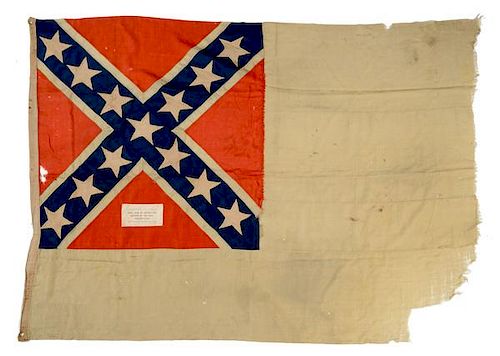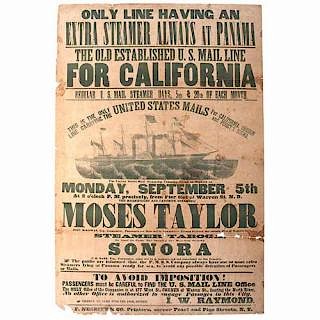Rare Confederate Stainless Banner Second National Arsenal Made Flag, Captured From Battery Bee, South Carolina
About Seller
6270 Este Ave.
Cincinnati , OH 45232
United States
With offices in Cincinnati, Cleveland and Denver, Cowan’s holds over 40 auctions each year, with annual sales exceeding $16M. We reach buyers around the globe, and take pride in our reputation for integrity, customer service and great results. A full-service house, Cowan’s Auctions specializes in Am...Read more
Two ways to bid:
- Leave a max absentee bid and the platform will bid on your behalf up to your maximum bid during the live auction.
- Bid live during the auction and your bids will be submitted real-time to the auctioneer.
Bid Increments
| Price | Bid Increment |
|---|---|
| $0 | $25 |
| $500 | $50 |
| $1,000 | $100 |
| $2,000 | $250 |
| $5,000 | $500 |
| $10,000 | $1,000 |
| $20,000 | $2,500 |
| $50,000 | $5,000 |
| $100,000 | $10,000 |
About Auction
Jun 10, 2016 - Jun 11, 2016
Cowan's Auctions dawnie@cowans.com
- Lot Description
Rare Confederate Stainless Banner Second National Arsenal Made Flag, Captured From Battery Bee, South Carolina
All hand-sewn, consisting of four panels of white wool bunting joined horizontally with flat felled seams. A rectangle of white bunting reinforces the lower hoist corner, and a smaller section of dark blue bunting serves as reinforcement in the upper hoist corner. Inset into the field and occupying the upper hoist corner of the flag is a rendition of the battle flag of the Confederate Army of Northern Virginia, consisting of a red wool bunting field traversed by a dark blue wool bunting St. Andrew's cross, bordered on its sides with a white wool bunting edging bearing 13 white cotton, five-pointed stars, at 8" intervals, each measuring 7" to 7.25" on the obverse side but only 5.5" to 6" across their points on the reverse side, where the blue backing of the cross has been cut away and under hemmed so as to expose the white cotton star from the obverse.
The leading edge of the flag is finished with a 2" wide white canvas duck heading bearing a "button hole" whipped eyelet at each end for attachment to halyards. Inked onto this heading (8" from lower obverse side) is the notation Battery Bee, Jan'y 1864 and 6x10 at the top of hoist. Sewn to the obverse side of the red field of the battle flag in its lower quadrant is an added rectangle of white cotton bearing the notation: Rebel flag at Battery Bee/ Entered by the Navy/ February 18, 1865.
The flag itself conforms to the Army revisions of the national flag adopted by the Confederate Congress on May 1, 1863, commonly referred to during the period as the Stainless Banner. The flag measures 64.5" on its hoist by 92.5" on the flag (with the later dimension probably worn down from an even 96", i.e. 8').
The date on the flag refers to the day when Union forces entered the abandoned defenses of Charleston, South Carolina after the city's evacuation by the Confederate army. The flag conforms to the style and size of the type produced for "posts and camps" by the Confederate Clothing Depot at Charleston, SC, and there is no reason to doubt the ascribed history written on the cotton patch sewn to the fly.
When the flag was issued in January, 1864, the forces that held "Battery Bee" were probably members of Company I, 1st South Carolina Regular Infantry (also known as the 3rd South Carolina Heavy Artillery) (see the Report of Captain Warren Adams, dated 20 November 1863, regarding the casualties incurred at "Battery Bee" on 19 November 1863 Official Records of the War of Rebellion, Series I, Vol. 28, Pt 1, p. 744.) Companies C and H were also garrisoned at the battery at at some point. Further research into the Confederate forces occupying Charleston in 1864 and 1865 may show, however that some other unit held Battery Bee at the time of the evacuation.
Battery Bee, so named under General Order dated November 4, 1862 (formerly Battery Enfilade), was situated on the "western extremity" of Sullivan's Island west of Fort Moultrie and designed to guard Charleston Harbor. Progressively enlarged, and mounting up to 11 heavy guns, the Battery was initially commanded by Lt. Col. L.M. Keitt, of the 20th South Carolina Infantry, and Post Commander of Sullivan's Island. By May 1864, the Battery was commanded by Major Warren Adams, 1st South Carolina Regular Infantry with two companies.
The Battery guns engaged Federal Naval forces on several occasions in 1863-64 with slight loss (detailed reports found in OR's). The city of Charleston and Battery Bee were evacuated on February 17, 1865 in orderly fashion (guns disabled, some critical stores withdrawn) and occupied by Federal troops under General Quincy Gillmore on February 18, 1865.
The Report of Captain Samuel Cuskaden, 52nd Pennsylvania, dated March 6, 1865, suggests fierce competition among Union regiments to be the first to plant a flag on the abandoned defenses. Cuskaden says that it was a small boat "race for the city" and mentions his own regiment, the 52nd PA, the 3rd Rhode Island Heavy Artillery (detachment) and the 21st USCT as vying for the honors. The 52nd planted its flag on Ft. Sumter while the Rhode Islander's took Ft. Moultrie. The National flag of the 52nd PA appears to have been the first over Charleston City.
No specific mention of the flag from Battery Bee is found in the Official Records though we can assume that once the defenses of Sullivan's Island collapsed, the flags of all of the batteries on the island were quickly seized. On February 18th Lt. Colonel A.W. Bennett of the 21st US Colored troops, reported that troops under his command had occupied Charleston and secured the flags of Fort Moultrie, Castle Pinckney, Fort Ripley, and seventeen signal pennants found in the city (Official Records, Chapter LIX: 1019).
An exceptional rarity; one of only a few known to have survived. Accompanied by a written analysis by Howard Madaus.
The flag passed on loan from Paul Verkamp of Cincinnati, OH to Lloyd L. Howard of the same, and was believed returned to the former's possession in October of 1995 after Mr. Howard's death. At the time of Mr. Verkamp's death, the flag was consigned to Cowan's Auctions, Inc.
The flag originally sold in Cowan's May 20-21, 2004 Historic Americana auction, as Lot 574.
Provenance: Property of Another Consignor - Shipping Info
-
SHIPPING. At the request of the buyer, Cowan's will authorize the shipment of purchased items. Shipments usually occur within two weeks after payment has been received. Shipment is generally made via UPS Ground service. Unless buyer gives special instructions, the shipping method shall be at the sole discretion of Cowan's Auctions, Inc.. Cowan's is in no way responsible for the acts or omissions of independent handlers, packers or shippers of purchased items or for any loss, damage or delay from the packing or shipping of any property.
-
- Buyer's Premium



 EUR
EUR CAD
CAD AUD
AUD GBP
GBP MXN
MXN HKD
HKD CNY
CNY MYR
MYR SEK
SEK SGD
SGD CHF
CHF THB
THB
















